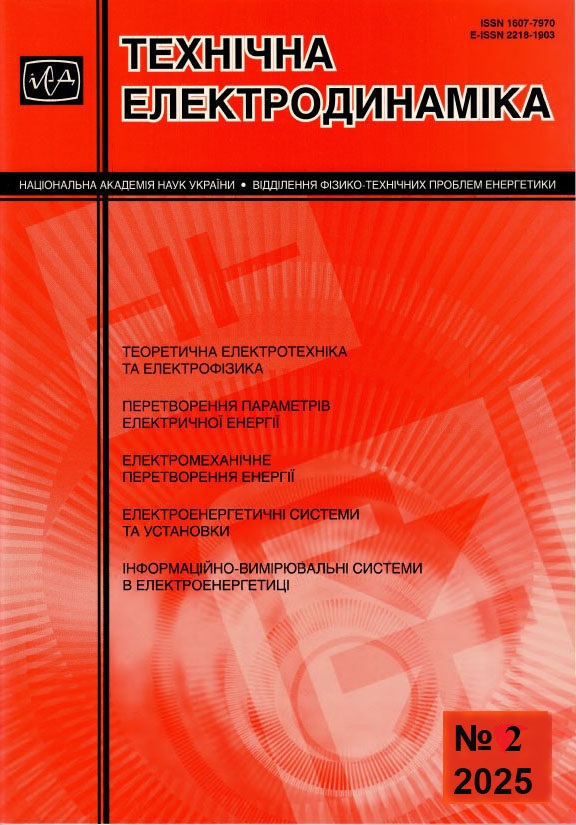Abstract
The vector torque control algorithm of synchronous reluctance motors (SynRM), which are deeply saturated electrical machines, is presented. The control algorithm design is based on a motor mathematical model with polynomial approximations of the flux-coupling functions that do not use trigonometric functions or multidimensional tables. The structure of the SynRM control system allows for the analytical and numerical formalization of the maximum torque per Ampere optimization. The resulting optimization procedure is much simpler than the existing ones and does not require long-term experimental tests, and is easily automated. The results of the vector control system testing with the proposed optimization algorithm confirm that it reduces power consumption in the torque zone by up to 50-70 % of the nominal value compared to the control system with constant flux coupling. At the same time, asymptotic tracking of the reference torque and flux-forming component of the stator current is achieved. The study results show that optimization has a greater effect for motors of lower power. References 16, figures 6, table 1.
References
Lipo T.A. Synchronous reluctance machines – A viable alternative for AC drives? Electric Machines & Power Sys-tems. 1991. Vol. 19. No 6. Pp. 659-671. DOI: https://doi.org/10.1080/07313569108909556.
Boglietti A., Cavagnino A., Pastorelli M., Staton D., Vagati A. Thermal analysis of induction and synchronous reluc-tance motors. IEEE Transactions on Industry Applications. 2006. Vol. 42. No 3. DOI: https://doi.org/10.1109/tia.2006.873668.
Consoli A., Russo F., Scarcella G., Testa A. Low- and zero-speed sensorless control of synchronous reluctance mo-tors. IEEE Transactions on Industry Applications. 1999. Vol. 35. No 5. Pp. 1050-1057. DOI: https://doi.org/10.1109/28.793365.
Lee H.D., Kang S.J., Sul S.K. Efficiency-optimized direct torque control of synchronous reluctance motor using feedback linearization. IEEE Transactions on Industrial Electronics. 1999. Vol. 46. No 1. Pp. 192-198. DOI: https://doi.org/10.1109/41.744411.
Yang Z., Shang F., Brown I.P., Krishnamurthy M. Comparative study of interior permanent magnet, induction, and switched reluctance motor drives for EV and HEV applications. IEEE Transactions on Transportation Electrification. 2015. Vol. 1. No 3. Pp. 245-254. DOI: https://doi.org/10.1109/TTE.2015.2470092.
Xu L., Xu X., Lipo T.A., Novotny D.W. Vector control of a synchronous reluctance motor including saturation and iron loss. IEEE Transactions on Industry Applications. 1991. Vol. 27. No 5. Pp. 977-985. DOI: https://doi.org/10.1109/28.90356.
Lubin T., Razik H., Rezzoug A. Magnetic saturation effects on the control of a synchronous reluctance machine. IEEE Transactions on Energy Conversion. 2002. Vol. 17. No 3. Pp. 356-362. DOI: https://doi.org/10.1109/TEC.2002.801731.
Accetta A., Cirrincione M., Piazza M.C.D., Tona G.L., Luna M., Pucci M. Analytical formulation of a maximum torque per Ampere (MTPA) technique for SynRMs considering the magnetic saturation. IEEE Transactions on Industry Applications. 2020. Vol. 56. No 4. Pp. 3846-3854. DOI: https://doi.org/10.1109/TIA.2020.2993525.
Bedetti N., Calligaro S., Petrella R. Self-adaptation of MTPA tracking controller for IPMSM and SynRM drives based on on-line estimation of loop gain. IEEE Energy Conversion Congress and Exposition (ECCE), Cincinnati, OH, USA, 01-05 October 2017. Pp. 1917-1924. DOI: https://doi.org/10.1109/ECCE.2017.8096029.
Wang S., Varvolik V., Bao Y., Aboelhassan A., Degano M., Buticchi G., Zhang H. Automated maximum torque per Ampere identification for synchronous reluctance machines with limited flux linkage information. Machines. 2024. Vol. 12(2). Pp. 1-19. DOI: https://doi.org/10.3390/machines12020096.
Rashad E.M., Radwan T.S., Rahman M.A. A maximum torque per ampere vector control strategy for synchronous reluctance motors considering saturation and iron losses. Record of the IEEE Industry Applications Conference, Seattle, WA, USA, 03-07 October 2004. Pp. 2411-2417. DOI: https://doi.org/10.1109/IAS.2004.1348813.
Bozhko S., Dymko S., Kovbasa S., Peresada S.M., Maximum torque-per-Amp control for traction IM drives: The-ory and experimental results. IEEE Transactions on Industry Applications. 2017. Vol. 53. No 1. Pp. 181-193. DOI: https://doi.org/10.1109/TIA.2016.2608789.
Peresada S., Nikonenko Y., Reshetnyk V. Identification of the interior permanent magnet synchronous motor elec-trical parameters for self-commissioning. IEEE 40th International Conference on Electronics and Nanotechnology (ELNANO), Kyiv, Ukraine, 22-24 April 2020. Pp. 826-831. DOI: https://doi.org/10.1109/ELNANO50318.2020.9088867.
Varvolik V., Buticchi G., Wang S., Prystupa D., Peresada S., Bozhko S., Galea M. High-fidelity model identifica-tion for synchronous reluctance motor drives. IEEE Transactions on Energy Conversion. 2023. Vol. 38. Issue 4. Pp. 2623-2633. DOI: https://doi.org/10.1109/TEC.2023.3277478.
Varvolik V., Wang S., Prystupa D., Buticchi G., Peresada S., Galea M., Bozhko S. Fast experimental magnetic model identification for synchronous reluctance motor drives. Energies. 2022. No 15. Pp. 1-15. DOI: https://doi.org/10.3390/en15062207.
Synchronous reluctance motor-drive package for machine builders. ABB. URL: https://search-ext.abb.com/library/Download.aspx?DocumentID=3AUA0000120962&LanguageCode=en&DocumentPartId=1&Action=Launch/ (accessed at 12.06.2024).

This work is licensed under a Creative Commons Attribution-NonCommercial-NoDerivatives 4.0 International License.
Copyright (c) 2025 Array






